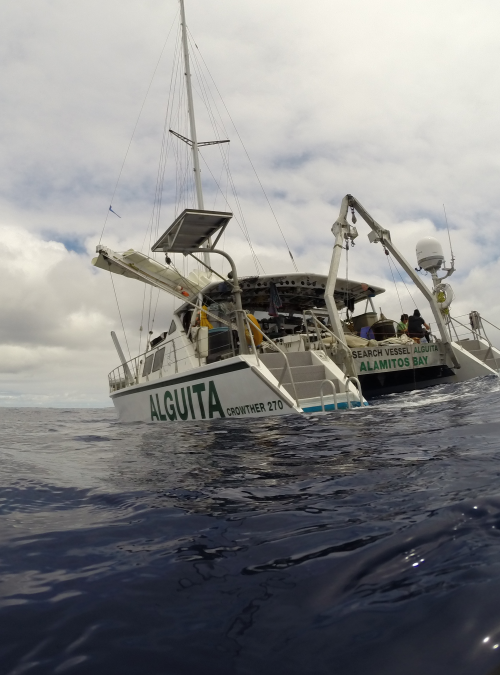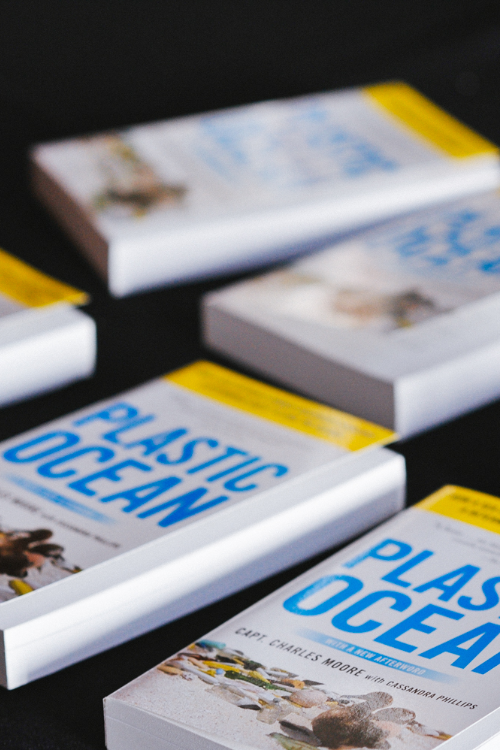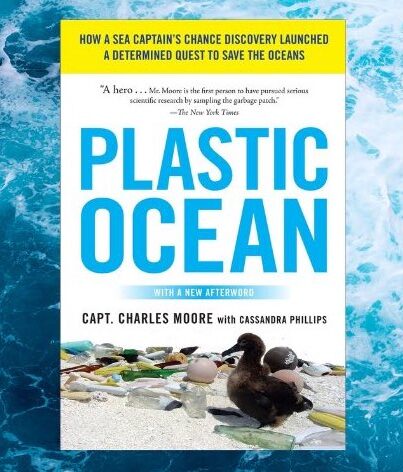
Lesson

Photo Credit: Algalita, 2014.
Compare themes between two texts, Plastic Ocean Chapter 1 by Charles Moore, and The Tempest by William Shakespeare and create maps to present the similarities and differences between the two storylines.
Grades 10 to 12 and first-year college
Time Needed 3 weeks (approximately) of class time with some expectations for independent reading leading up to the Final Writing & Map Making Project
Materials
- Copy of first core text: Plastic Ocean by Captain Charles Moore, Chapter 1: Plastic Soup [excerpt coming soon]
- Link to second core text: “No Fear Shakespeare: The Tempest” – the entire text as well as scene summaries, quizzes, flashcards, and infographic: https://www.sparknotes.com/nofear/shakespeare/tempest/
Editable Handouts
– Plastic Soup in a Brave New World – Theme and Quotation Journal Template Google Doc (includes samples)
This lesson was created by high school and university English Language Arts instructor Sarah King and is part of the “Plastic Ocean” English Language Arts Toolkit.
This lesson plan functions as a unit that may also be paired with the lesson titled “A Timeline of Throwaway Living and a Preconceived Endgame.”
Purpose and Context
The Tempest is a play which Shakespeare wrote near the end of his life and explores the consequences of European colonialism and settlement in the New World. While the connections to Plastic Ocean by Captain Charles Moore may not be immediately obvious aside from both texts making specific references to the ocean, it is fascinating to consider the significant themes that Shakespeare emphasized in the play over four hundred years ago, in 1611, which align with Moore’s awareness of the plastic pollution crisis, the power represented in corporations perpetuating this crisis with the excessive production of plastic, the consequent rise of a “throw away” culture, and the sense of responsibility gained to “shape a message and find himself living it” (Moore preface). This message is one which both Moore and Prospero share in terms of their awareness of human responsibility to care for the earth and each other, to intentionally engage in positive relationships, and to act in ways that demonstrate a genuine commitment to this responsibility instead of following historical hypocrisy in which those in power make the rules but don’t have to follow them. Both Shakespeare and Moore’s acknowledgment of human privilege and responsibility provide a focal point for their audiences to realize the narratives that remain relevant throughout history. Therefore, the current generation (wherever that falls on the historical timeline- 17 century or 21st century) must take ownership of this responsibility in order for future generations to both inherit a positive cultural environment as well as take leadership in it.
In the preface to Plastic Ocean, Captain Moore describes his journey to writing the book and his own evolution from citizen-scientist to conservation activist with specific details that resonate with Prospero’s journey in The Tempest. Moore states, “We’re dealing here with fragments, in space, place, and time, where boundaries between land and ocean are porous and barely seem to exist, and yet the dots do connect. This is also a love story, because I would not be doing any of what I do were it not for my deep and lifelong love of the ocean” (Preface). Like Captain Moore, Prospero is a person who represents authority through life experience and education, but it is important to note that both people demonstrate their commitment to continued research over time with a deep value for reading, investigating with intentional questions, and seeking answers with a goal for improvement and making their environment better than it was before. This is particularly inspiring as both people, one real, one fictional, demonstrate the hope that must exist in life to help us experience our ultimate value. We humans are not able to achieve this value unless we are willing to learn, and both Captain Moore and Shakespeare, through Prospero, demonstrate this with eloquence as they express the positive results of a life dedicated to learning and the reminder of the unfortunate consequences if we do not.
Instructions
Part 1: Reading and Text Comparison
- Students will read The Tempest, by William Shakespeare and identify literary connections between characters and themes in the play with Captain Charles Moore’s exploration and observations of the Pacific Ocean, the North-Pacific Gyre, The Great Pacific Garbage Patch, and the plastic pollution crisis.
- Students will reference the two texts to think critically, strategically, and creatively regarding their understanding of the role of the ocean in both texts, the importance of geographical locations in each text, as well as significant themes that provide current and relevant discussion points regarding human interactions with each other and the environment.
- Students will pair the readings above with additional readings to further extend the literary connections and discussion points regarding their awareness of the ocean and conservation efforts either before and/or after completing the readings in Objective 1. Some suggestions for additional reading are not limited to the following list:
- Students are encouraged to investigate current events and articles addressing the plastic pollution crisis and other topics regarding conservation and environmentalism.
- Students are encouraged to follow Captain Moore and the Algalita team on social media via Instagram or other platforms: @algalitacapnmoore and @algalita
- More suggestions for additional reading: https://lithub.com/5-great-island-books-that-reimagine-the-tempest/
- More text suggestions: https://www.goodreads.com/list/show/656.Nautical_Novels
- More text suggestions with specific attention to female authors and characters: https://www.theguardian.com/books/2019/feb/27/top-10-books-about-women-and-the-sea
- Quick List of text suggestions for pairing are: The Rime of the Ancient Mariner, by Samuel Taylor Coleridge (Moore references this poem in Plastic Ocean, Chapter 1, page 2) The Old Man and the Sea, by Ernest Hemingway, The Odyssey, by Homer, Brave New World, by Aldous Huxley
- Students will focus on the two main characters in the core texts: Captain Charles Moore (nonfictional) and Prospero (fictional) to compare and contrast their roles, and experiences, and journey. Each person’s interaction with the ocean is generated with specific intentions which students will explore.
- Students will consider the authors’ intentions in terms of style of writing and how each genre functions to capture the audience’s attention while considering the goals of fiction vs. nonfiction.
- Plastic Ocean is a non-fiction memoir presenting Captain Moore’s experiences while sailing on the Pacific Ocean and his developing activism against the plastic pollution crisis.
- The Tempest is a fictional comedic play telling the story of Prospero, Duke of Milan, who is usurped and sent away on a boat with his daughter and how they build a new life for themselves on a remote island.
- Students will keep a Theme and Quotation Journal (see template under Materials) to record significant themes and supporting quotations from each text. Since Moore’s Chapter 1 “Plastic Soup” is 19 pages, students are encouraged to find 5-10 significant quotations that relate to the shared themes between texts.
- Students will participate in class and small group discussions and activities generated by specific topics in the texts with particular emphasis on comparing and contrasting important details from the quotations and shared themes.
Part 2: Geography/Map Project
Students will complete this unit with a map project, presentation, and written reflection revealing significant details about the geography, role of the ocean, and human interaction from each text.
- Students will consider the value of maps, how they are used today (hard copy or virtual/AI, Google, etc.)
- Students will investigate how maps may be a useful tool, how can a map solve a problem?
- Students will research the journeys and locations of both Captain Moore and Prospero as indicated in each text. Moore’s locations are real, Prospero’s are fictional, so there is a creative interpretation component to this assignment.
- Students will create two maps using assorted tools- apps such as Stepmap.com or paper, markers, crayons, etc.
- Students will not be graded based on artistic ability; however, clear effort must be made to demonstrate a reasonable attempt to create a map with clear locations and references to the texts.
- The Map Assignment may be modified for a variety of classroom goals; however, specific instructions should include:
- Students will make 2 maps which include a minimum of 5 locations.
- One map will trace significant places in Captain Moore’s journey to activism in Chapter 1, “Plastic Soup.” These locations must be supported with specific evidence from the text with direct quotations that indicate the specific “place” on the map. Students will be asked to defend why each place is significant to this person and their journey.
- The other map will trace significant places in Prospero’s fictional journey from Milan to a remote island in a large body of water beyond Italy, in The Tempest. The locations starting in Milan and on various places on the island must be supported with specific evidence from the text with direct quotations that indicate the specific “place” on the map. Students will be asked to defend why each place is significant to this person and their journey.
Facilitation suggestions: This map project may be an excellent opportunity for collaboration as classes could be divided into groups to make the maps together. Another variation is that students work independently to make each map with specific attention to a third map, their own “life map” by identifying significant places in their life in which they learned a valuable lesson or became an “activist” in some way.
Part 3: Presenting the Maps
Students will share their maps in class as presentations. All maps should be able to be photographed or uploaded to project on screen. Creating an online discussion board where students upload their maps is also useful to create a digital class gallery so all can view all maps online.
Part 4: Independent Writing and Reflection
Students will engage in writing as determined by the teacher to reflect on the process of the unit, reactions to the texts, insights from the Quotation Journals, and conclusions gained from making the maps and making comparisons between Captain Moore and Prospero.
One suggestion is to ask students to recall one favorite quotation from each text and write why each quotation especially resonates with them- How do these quotations inspire students to take action in a specific way?
Another question for reflection is to ask students to add an additional text of their choice to this conversation – What is the title, who is the author, and in why do they make this connection?
Tips and Suggestions
Given that this is a literary assignment, there is a lot of flexibility in how this unit is presented and achieved. At the core of this assignment is the effort to pair two texts (with the potential to add more) from different time periods and recognize the similar intentions and values in each text.
Associated Standards
NCTE/IRA Standards for the English Language Arts
- Students read a wide range of print and nonprint texts to build an understanding of texts, of themselves, and of the cultures of the United States and the world; to acquire new information; to respond to the needs and demands of society and the workplace; and for personal fulfillment. Among these texts are fiction and nonfiction, classic and contemporary works.
- Students read a wide range of literature from many periods in many genres to build an understanding of the many dimensions (e.g., philosophical, ethical, aesthetic) of human experience.
- Students apply a wide range of strategies to comprehend, interpret, evaluate, and appreciate texts. They draw on their prior experience, their interactions with other readers and writers, their knowledge of word meaning and of other texts, their word identification strategies, and their understanding of textual features (e.g., sound-letter correspondence, sentence structure, context, graphics).
- Students adjust their use of spoken, written, and visual language (e.g., conventions, style, vocabulary) to communicate effectively with a variety of audiences and for different purposes.
- Students employ a wide range of strategies as they write and use different writing process elements appropriately to communicate with different audiences for a variety of purposes.
- Students apply knowledge of language structure, language conventions (e.g., spelling and punctuation), media techniques, figurative language, and genre to create, critique, and discuss print and nonprint texts.
- Students conduct research on issues and interests by generating ideas and questions, and by posing problems. They gather, evaluate, and synthesize data from a variety of sources (e.g., print and nonprint texts, artifacts, people) to communicate their discoveries in ways that suit their purpose and audience.
Did you use this lesson?
Help us track our reach
Related Resources
"Plastic Ocean" English Language Arts Toolkit
Research, comprehend, discuss, and communicate about the problem of plastic pollution and solutions to this global challenge through a literary lens.
Grades 9 and up
Variable Timing
Lesson: A Timeline of Throwaway Living and a Preconceived Endgame
Analyze the historical events that led to contemporary attitudes towards waste and throw-away culture through a collection of book excerpts, articles, and other publications, and develop a potential future outcome for an end to the culture of disposability.
Co-created with educator Sarah King
Grades 9 and up
2-3 weeks







